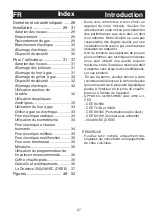
40
INSTALLATION
The appliance must be installed by qualifi ed
staff working in accordance with the regula-
tions in force.
Before installing, ensure that the appliance
is correctly preset for the local distribution
conditions (gas type and pressure).
The presettings of this appliance are indicat-
ed on the nameplate shown on the cover.
This appliance is not connected to a fl ue gas
extractor device. It must be installed and
connected in accordance with the regula-
tions in force.
This appliance may only be installed and
may only operate in rooms permanently
ventilated in accordance with national regu-
lations in force.
VENTILATION
The rooms in which gas appliances are in-
stalled must be well ventilated in order to al-
low correct gas combustion and ventilation.
The air fl ow necessary for combustion is at
least 2 m
3
/h for each kW of rated power.
POSITIONING
Remove the packaging accessories, includ-
ing the fi lms covering the chrome-plated and
stainless steel parts, from the cooker.
Position the cooker in a dry, convenient and
draft-free place. Keep at an appropriate dis-
tance from walls which may be damaged by
heat (wood, linoleum, paper, etc.).
The cooker may be free-standing (class 1)
or between two units (in class 2 st 2-1) the
sides of which must withstand a temperature
of 100°C and which must not be higher than
the working table.
CONNECTING TO THE GAS SUPPLY
Before connecting the cooker, check that it
is preset for the gas to be used.
The connection is on the right; if the pipe
has to pass behind the cooker, it must be
kept low down where the temperature is
about 50°C.
-
Rigid connectio
n (see fi g. 3 A and B)
The connection to the mains gas supply
may be made using a rigid metal pipe or
with a metal hose. Remove the hose con-
nector (if already fi tted) and screw the rigid
union onto the threaded connection of the
gas train (see fi g. 3 A). The union for rigid
connection may already be fi tted on the
gas train, or may be amongst the cooker
accessories. Otherwise, it can be obtained
from your dealer.
If national regulations permit, a metal hose
complying with the national standards can
be screwed directly onto the threaded con-
nection of the gas train, fi tting a seal (see
fi g. 3B).
However, users are strongly recommended
always to fi t the rigid union.
- Connection using a rubber hose
(see fi g.
3 C and D)
Connect a rubber hose carrying the con-
formity mark currently in force to the hose
connector. The hose must be replaced at
the date indicated at the latest, and must
be secured at both ends using standard
hose clamps. It must be absolutely
accessible to allow its condition to be
checked along its entire length.
CAUTION:
- Use of the hose connector is only per-
mitted for free-standing installation. If
the appliance is installed between two
class 2 st. 2-1 unions, the rigid union is
the only form of connection permitted.
IMPORTANT:
- After installation, check that the con-
nections are airtight.
- Use only standard rubber hoses.
- Avoid sharp bends in the pipe and keep it
well way from hot surfaces.
- References to the regulations covering the
gas connection to the appliance: ISO 7-1
(NL)
CONNECTING TO THE ELECTRICAL
MAINS
Before making the connection, check that:
- the mains voltage is as indicated on the
Installation
GB













































